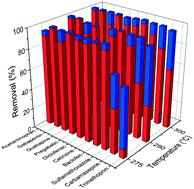当前位置:
X-MOL 学术
›
Environ. Sci.: Water Res. Technol.
›
论文详情
Our official English website, www.x-mol.net, welcomes your
feedback! (Note: you will need to create a separate account there.)
Comprehensive evaluation of non-catalytic wet air oxidation as a pretreatment to remove pharmaceuticals from hospital effluents
Environmental Science: Water Research & Technology ( IF 3.5 ) Pub Date : 2021-5-25 , DOI: 10.1039/d1ew00203a Valérie Boucher 1 , Margot Beaudon 1 , Pedro Ramirez 2 , Pascal Lemoine 2 , Kalyssa Volk 3 , Viviane Yargeau 3 , Pedro A. Segura 1
Environmental Science: Water Research & Technology ( IF 3.5 ) Pub Date : 2021-5-25 , DOI: 10.1039/d1ew00203a Valérie Boucher 1 , Margot Beaudon 1 , Pedro Ramirez 2 , Pascal Lemoine 2 , Kalyssa Volk 3 , Viviane Yargeau 3 , Pedro A. Segura 1
Affiliation

|
Removal of pharmaceuticals from wastewater using chemical processes is a promising solution to mitigate pollution in drinking and surface waters. Non-catalytic wet air oxidation (WAO) is a highly efficient advanced oxidation process that uses air and water at high temperatures and pressures to remove high concentrations of organic compounds from various wastes without use of catalysts. However, the elimination of pharmaceuticals in hospital wastewater with a low organic content by WAO has not yet been sufficiently studied. The objective of the present study was to evaluate both the efficiency and costs of WAO treatment to remove pharmaceuticals present in hospital effluents. First, a laboratory-scale WAO batch unit was used to optimize oxidation temperatures and residence times to achieve high elimination of ten pharmaceuticals of interest in spiked deionized water. Then, optimal conditions were applied to treat hospital wastewater effluents. Results showed that even at low chemical oxygen demand values (<600 mg O2 per L), WAO at 290 °C with 15 min residence time removed between 95.0% and 99.1% of the target compounds spiked at 10 μg L−1 in hospital wastewater. Acute toxicity bioassays using the crustacean Daphnia magna and the bacterium Aliivibrio fischeri showed that the toxicity of hospital wastewater increased after WAO treatment due to the generation of transformation products. However, since the intended use of WAO is as pretreatment for hospital effluents before municipal water treatment, it is not yet clear if WAO treated effluents could affect bacteria in activated sludge. The study included a techno-economic analysis to evaluate capital expenditures (CAPEX) and operational expenditures (OPEX) of an industrial-scale WAO unit to remove pharmaceuticals from the wastewater effluent of a local hospital. This analysis demonstrated that CAPEX for an 86 L min−1 WAO industrial-scale unit was $ 2.35m (in Canadian dollars), while OPEX was $ 1.09m, which corresponds to a relative price of $ 27 per m3. Initial investment for the WAO unit might be reduced by up to 44% by employing a preconcentration unit to increase the effluents' chemical oxygen demand in smaller volumes which could also make the process autothermal while reducing WAO's operating expenses by more than 20%.
中文翻译:

非催化湿式空气氧化作为去除医院污水中药物的预处理的综合评价
使用化学过程从废水中去除药物是减轻饮用水和地表水污染的有希望的解决方案。非催化湿式空气氧化 (WAO) 是一种高效的高级氧化工艺,它在高温高压下使用空气和水,在不使用催化剂的情况下从各种废物中去除高浓度的有机化合物。然而,WAO对医院废水中有机物含量低的药物的去除尚未得到充分研究。本研究的目的是评估 WAO 处理去除医院废水中存在的药物的效率和成本。第一的,实验室规模的 WAO 批处理单元用于优化氧化温度和停留时间,以实现在加标去离子水中高度消除十种感兴趣的药物。然后,应用最佳条件处理医院废水。结果表明,即使在低化学需氧量值(<600 mg O2 /L),WAO 在 290 °C 下停留 15 分钟,去除了医院废水中95.0% 到 99.1% 的目标化合物,浓度为 10 μg L -1。使用甲壳动物Daphnia magna和Aliivibrio fischeri细菌进行急性毒性生物测定表明 WAO 处理后医院废水的毒性由于转化产物的产生而增加。然而,由于WAO的预期用途是在市政水处理之前对医院污水进行预处理,目前尚不清楚WAO处理的污水是否会影响活性污泥中的细菌。该研究包括一项技术经济分析,以评估工业规模 WAO 装置从当地医院废水中去除药物的资本支出 (CAPEX) 和运营支出 (OPEX)。该分析表明,86 L min -1 WAO 工业规模装置的CAPEX 为235 万美元(以加元计),而 OPEX 为 109 万美元,对应的相对价格为每平方米 27 美元3. WAO 装置的初始投资最多可减少 44%,通过使用预浓缩装置以更小体积增加流出物的化学需氧量,这也可以使工艺自热,同时将 WAO 的运营费用降低 20% 以上。
更新日期:2021-06-01
中文翻译:

非催化湿式空气氧化作为去除医院污水中药物的预处理的综合评价
使用化学过程从废水中去除药物是减轻饮用水和地表水污染的有希望的解决方案。非催化湿式空气氧化 (WAO) 是一种高效的高级氧化工艺,它在高温高压下使用空气和水,在不使用催化剂的情况下从各种废物中去除高浓度的有机化合物。然而,WAO对医院废水中有机物含量低的药物的去除尚未得到充分研究。本研究的目的是评估 WAO 处理去除医院废水中存在的药物的效率和成本。第一的,实验室规模的 WAO 批处理单元用于优化氧化温度和停留时间,以实现在加标去离子水中高度消除十种感兴趣的药物。然后,应用最佳条件处理医院废水。结果表明,即使在低化学需氧量值(<600 mg O2 /L),WAO 在 290 °C 下停留 15 分钟,去除了医院废水中95.0% 到 99.1% 的目标化合物,浓度为 10 μg L -1。使用甲壳动物Daphnia magna和Aliivibrio fischeri细菌进行急性毒性生物测定表明 WAO 处理后医院废水的毒性由于转化产物的产生而增加。然而,由于WAO的预期用途是在市政水处理之前对医院污水进行预处理,目前尚不清楚WAO处理的污水是否会影响活性污泥中的细菌。该研究包括一项技术经济分析,以评估工业规模 WAO 装置从当地医院废水中去除药物的资本支出 (CAPEX) 和运营支出 (OPEX)。该分析表明,86 L min -1 WAO 工业规模装置的CAPEX 为235 万美元(以加元计),而 OPEX 为 109 万美元,对应的相对价格为每平方米 27 美元3. WAO 装置的初始投资最多可减少 44%,通过使用预浓缩装置以更小体积增加流出物的化学需氧量,这也可以使工艺自热,同时将 WAO 的运营费用降低 20% 以上。









































 京公网安备 11010802027423号
京公网安备 11010802027423号